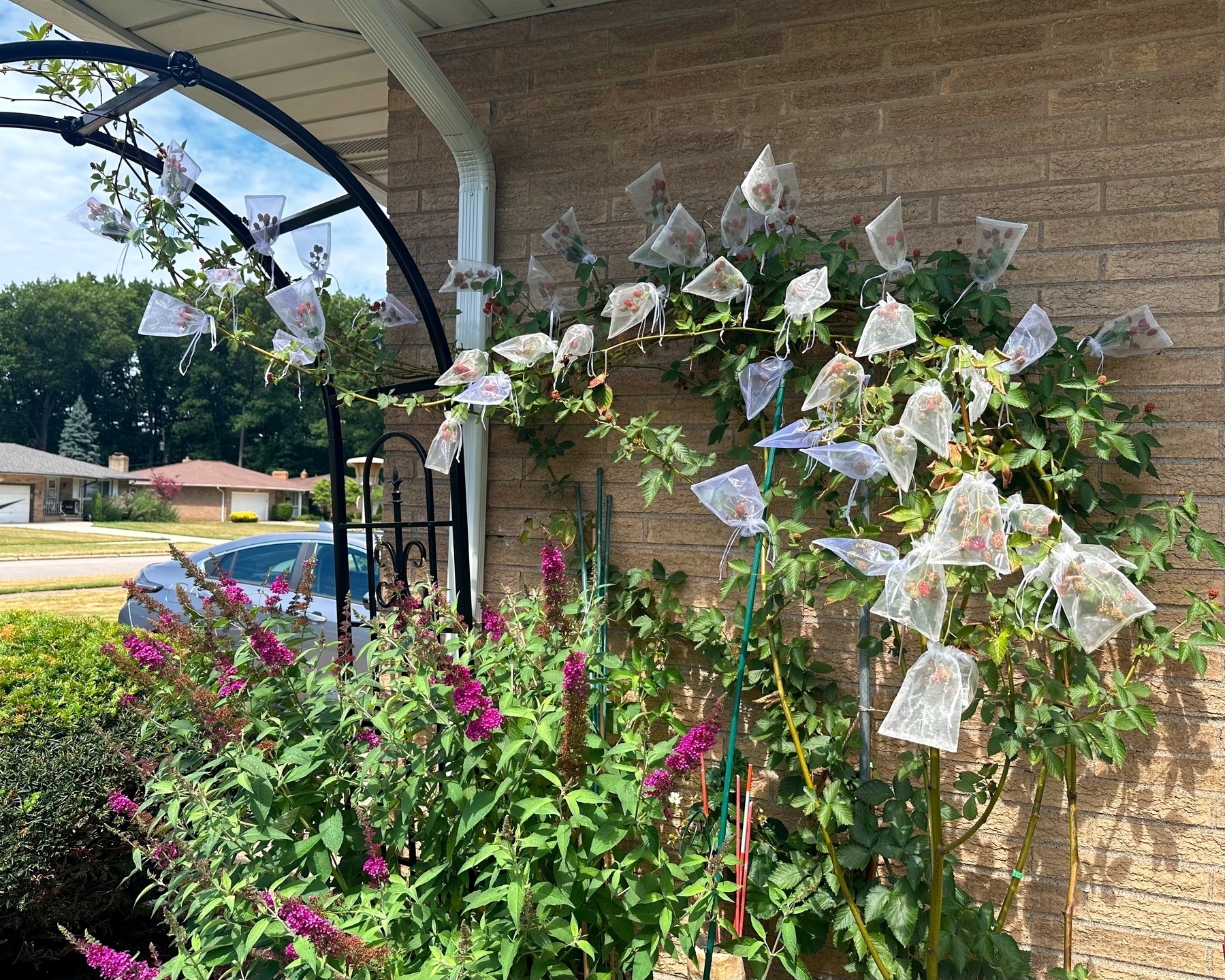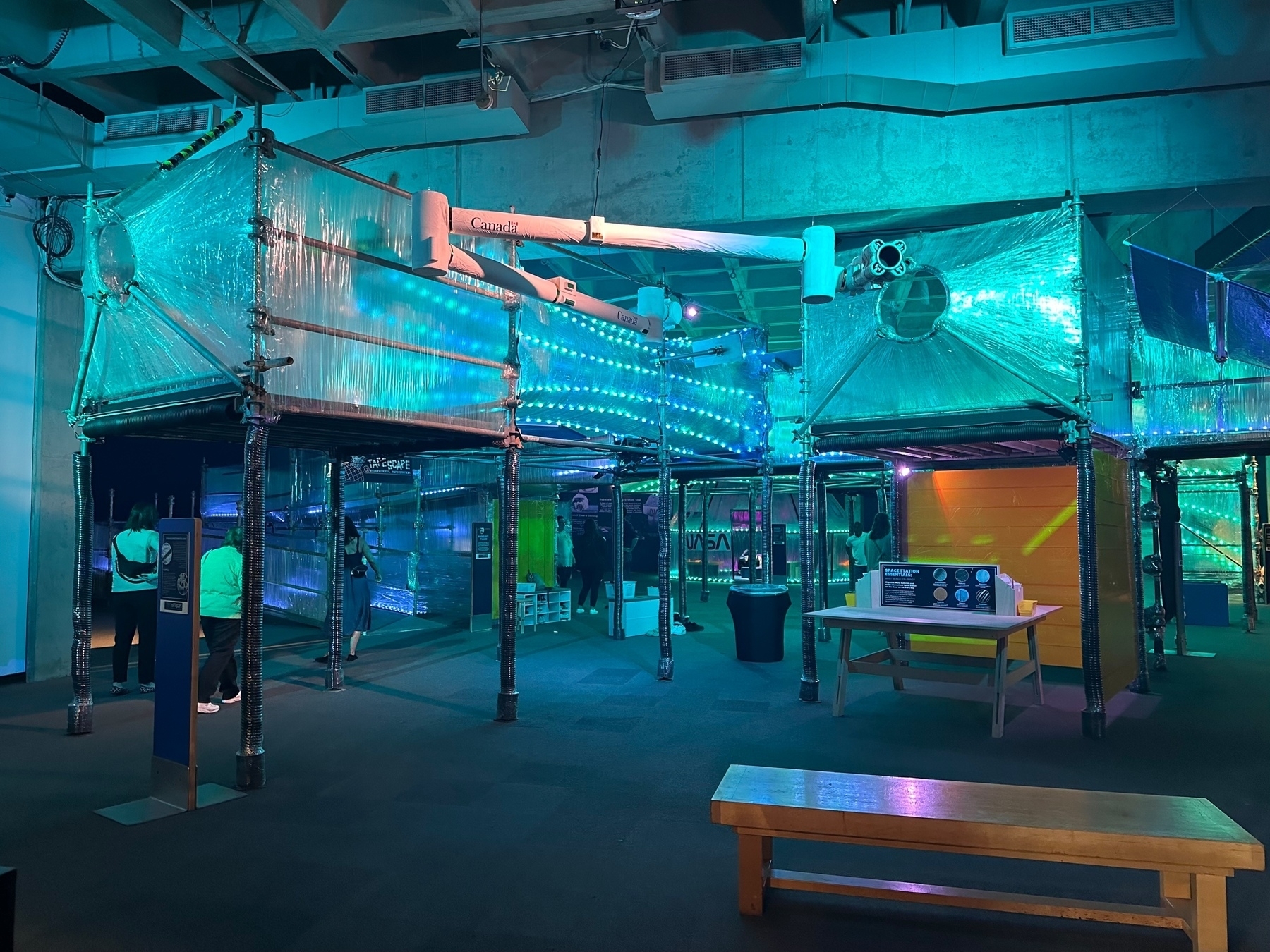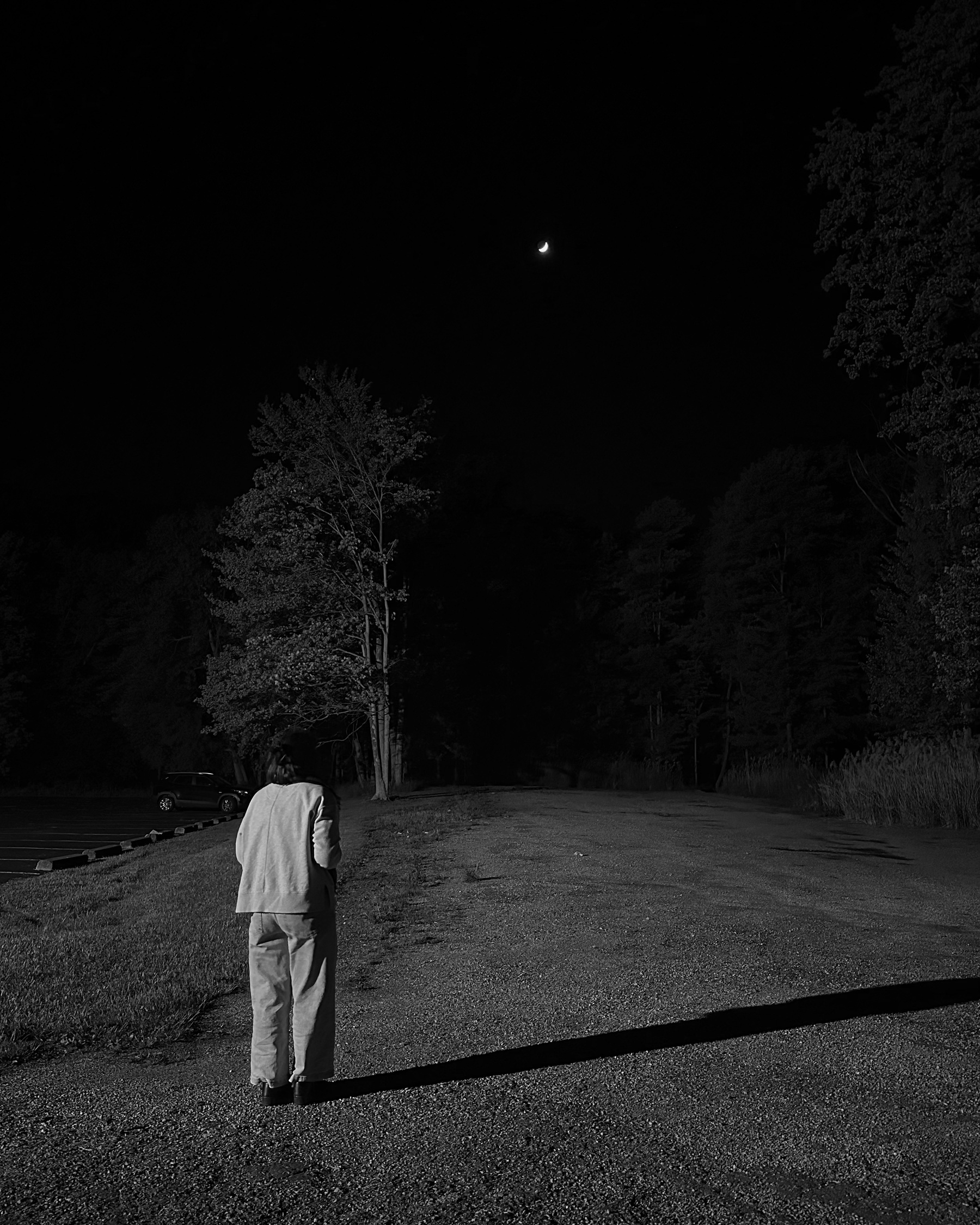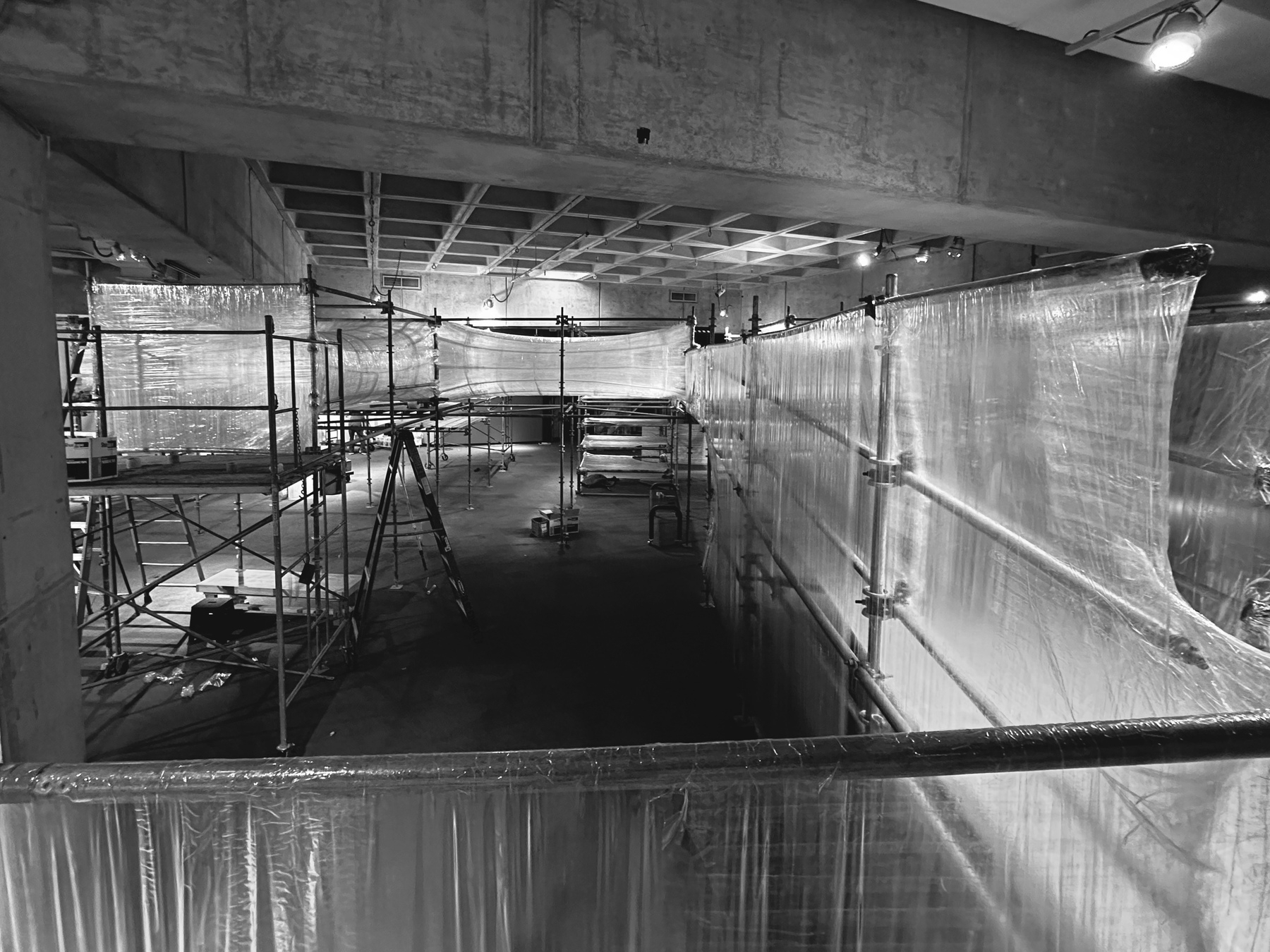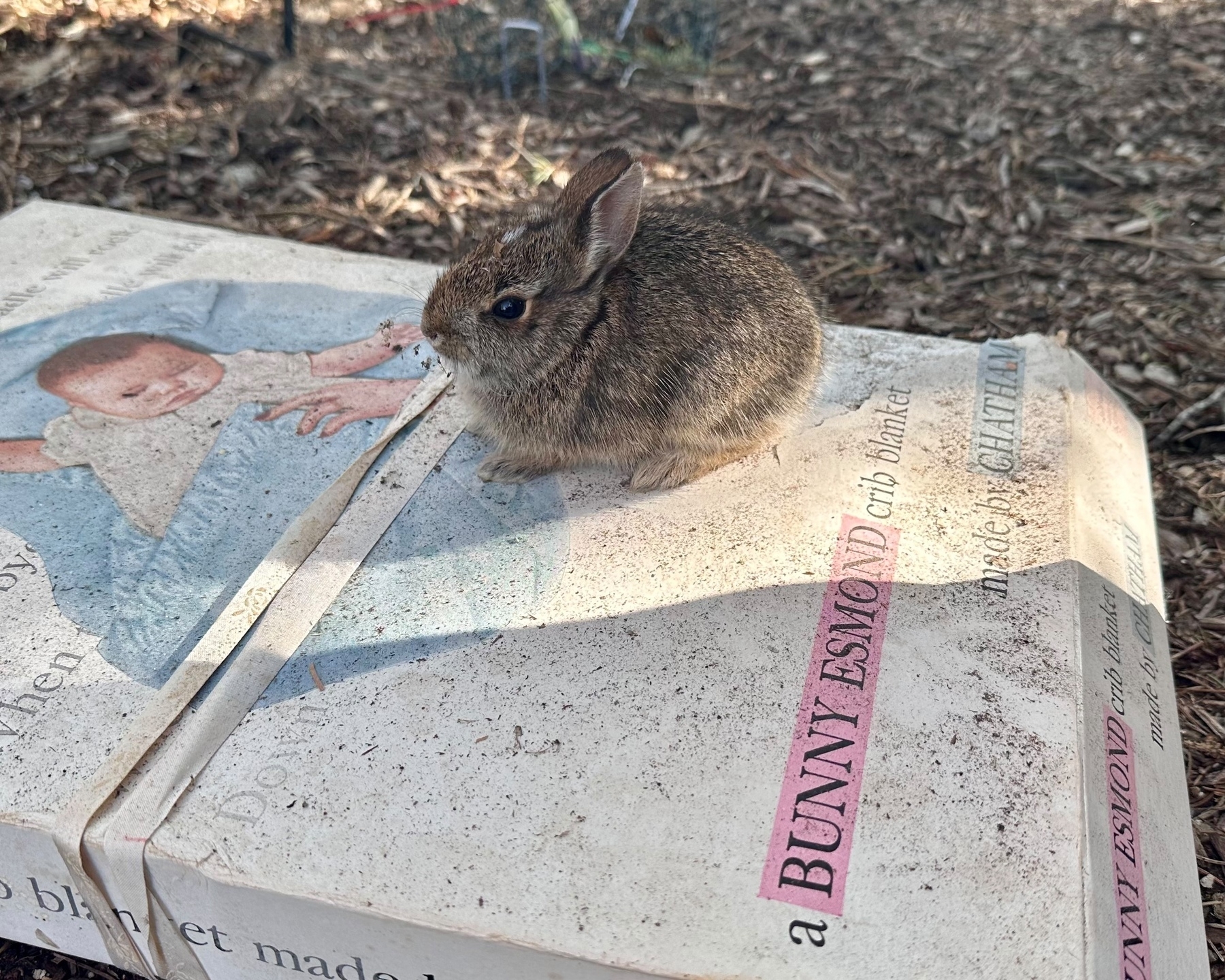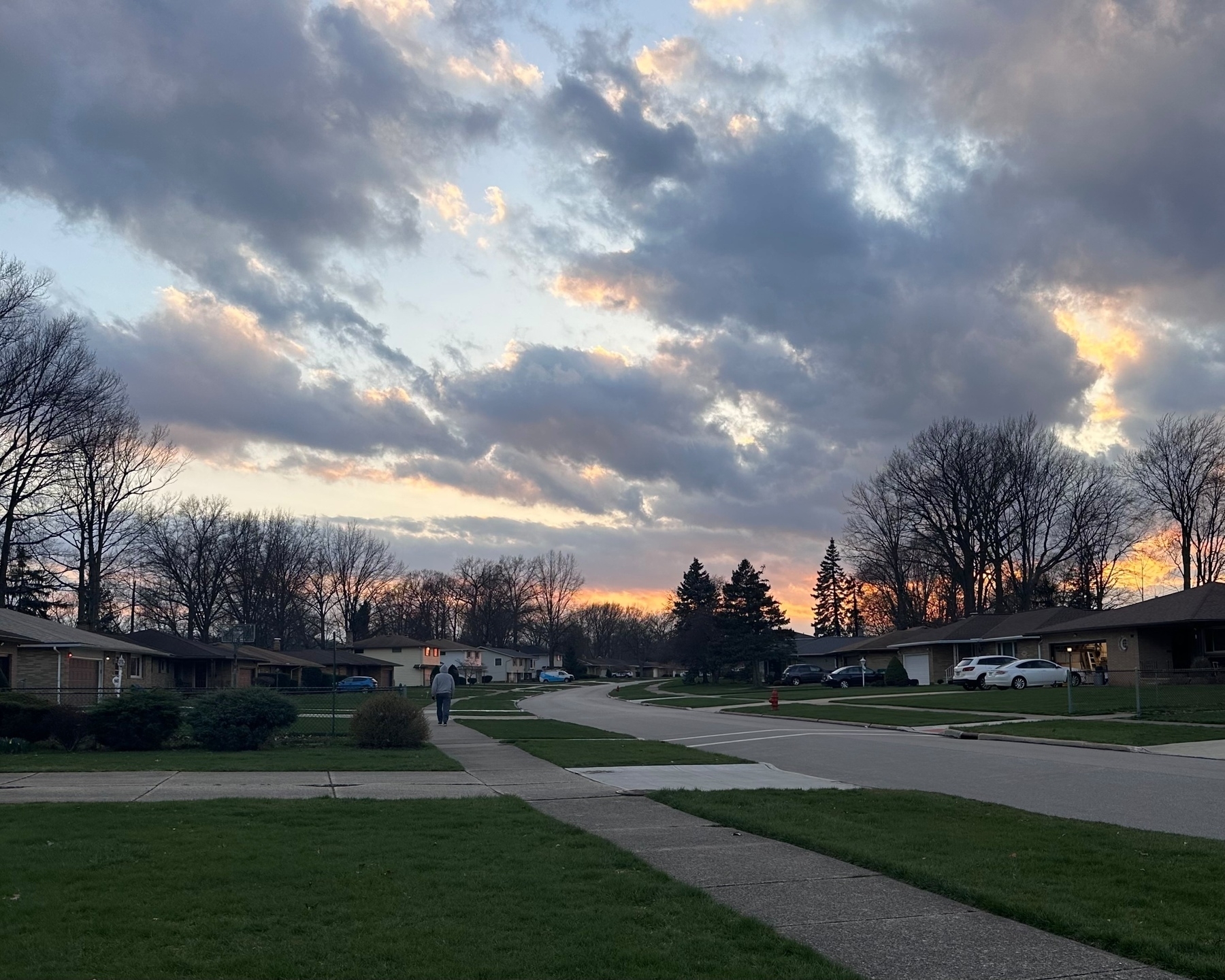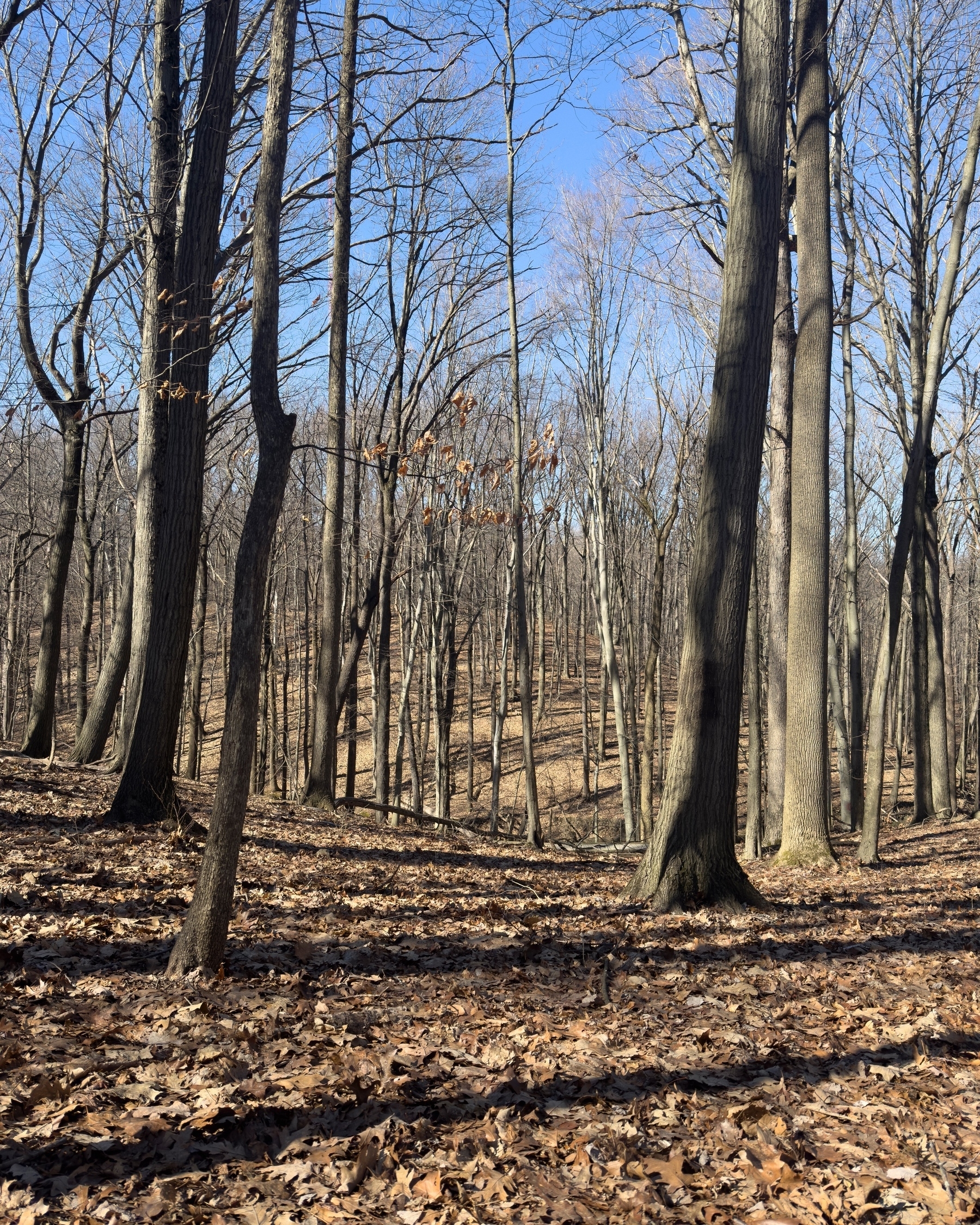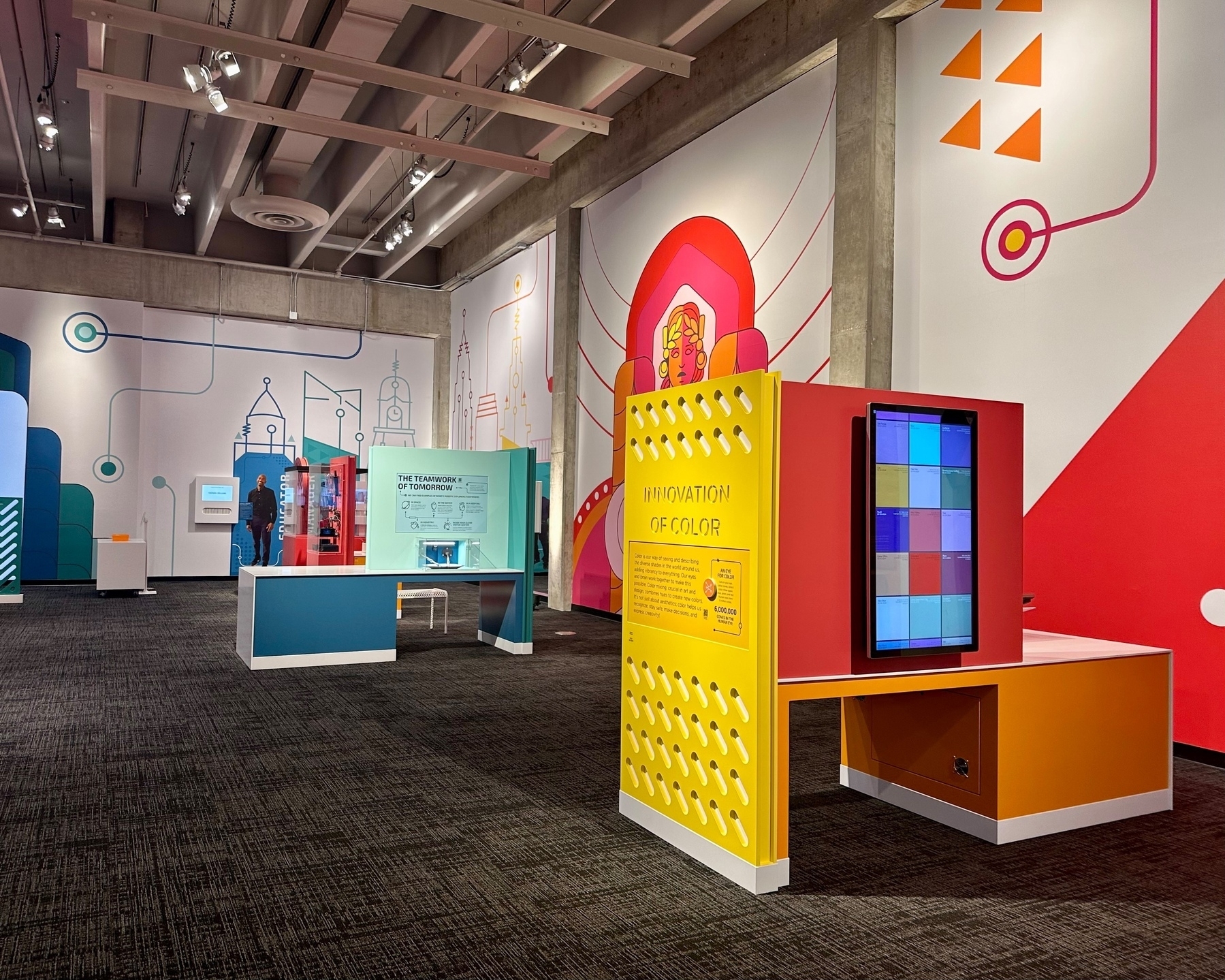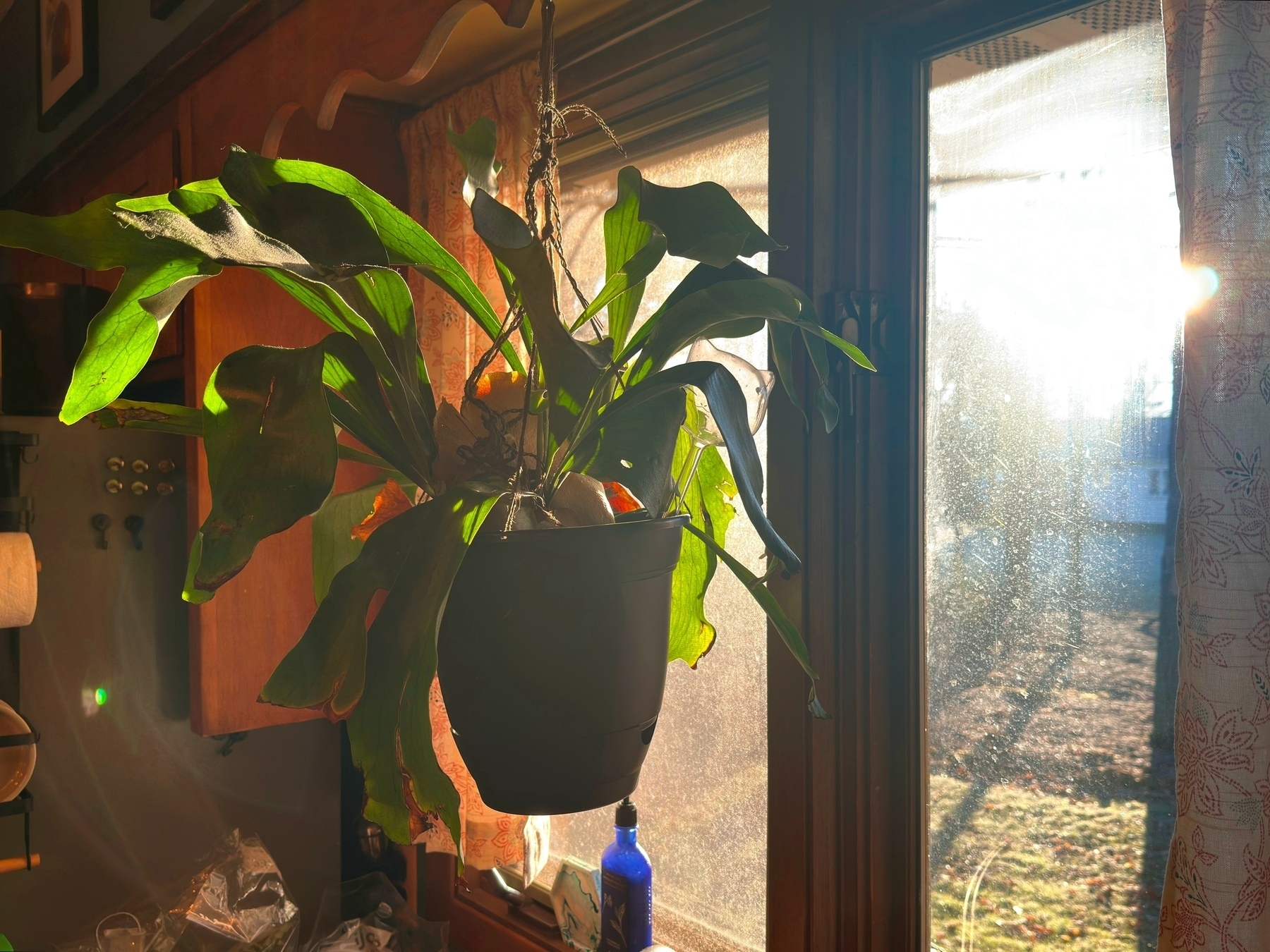-
§ Holding out four months since my last one, I caught a nasty cold at the beginning of the week. The only consolation is that it is better to get it over with now than pretty much any other time in July where it would either throw a wrench into my wedding or be a drag on the honeymoon. Still, not fun at all.
§ Where everything related to the garden was a little bit delayed last year, everything seems just a little bit early this season. Our first few cherry tomatoes are ripening. Last year we didn’t start getting tomatoes until the tail end of July.
On a related note, the first blackberries of the season have ripened too. I’m hopeful they will be sweeter than they were last year. It is hard to tell from the small handful I’ve picked so far—they might be? That reminds me, I need to check back in on the wild black raspberries soon too.
§ Have I told you about our strange variegated borage? It suddenly popped up this spring, self-seeded from a bog-standard borage plant we grew a few years ago. I guess you can buy bespoke seeds for it under the name “Bill Archer“. Maybe I’ll try saving the seeds from my plant. I am interested to see whether or not the variegation is passed down.
§ It feels like I set aside season two of The Bear just the other week, always meaning to revisit it, and suddenly the third season is already out? Looking at the actual dates, I guess it has actually been a full year. Early reviews suggest it is as good as ever. There is something about the show’s unique atmosphere of simmering tension and creative camaraderie that is totally electric when done right.
§ I finished Moonbound.
It is at its best when the protagonist, Ariel, is in motion. When the novelty flywheel starts to slow and days settle into an undifferentiated blur the whole mood turns sour. There is an in-story justification for this. Our narrator—through a clever plot device I wouldn’t dare spoil for you here—was unexpectedly thrust forward thousands of years into the future and is soaking up every little oddity right alongside us, the reader. Our narrator constantly craves new information to help piece together the missing millennia.
Moonbound is, at its core, an adventure novel. Nevertheless, every location we visit is almost unnecessarily well considered—completely alive. I could read a book set in the serious foggy alleyways of Wyrd. I could read a book set in the dense city streets of Rath Varia, always evolving and impossibly thrifty. I could read a book about how the citizens of Rath-wold use architecture as a form of communication.
Sloan has already mentioned that he views Moonbound as part of a wider series. So what happens next? A continuation of Ariel’s story? A prequel as told by Durga? More flavor on The Chroniclers previous subjects? Maybe we’ll be thrust forward a few more millennia. Whatever it is, I’m ready.
§ Our wedding is next week. Just now I got my first glimpse at the weather forecast: sunny and hot.
There has been a sort of simmering ambient anxiety about it ever since I got engaged last year. It isn’t the being married part that stresses me out—I’ve been with my fiancée for more than a decade—it’s the event planning. The feeling that if I don’t throw an adequately nice party I will have ruined a perfectly nice Saturday for all of my closest friends and family. Typing this out, I realize how silly it all sounds but anxiety has only a passing correlation to plausibility.
Anyway, as the stress reaches its zenith a new feeling is taking shape which is the growing realization of how great I’m going to feel once this is all finished.
§ A big weekend for events with both the Cleveland lantern festival and the Lebanese Food & Music Festival. The lantern festival was enormous and whimsical and the food & music festival had all the name promised along with a lively dose of dabke dancing. I can highly recommend both.
§ Links
- Keenan moved their blog off of Squarespace and wrote an alarmingly concise and very hinged summary of what it was like to rebuild it from scratch
-
§ Monday was my one year anniversary at my current job. It is wild to think about the variety of challenges I’ve had the opportunity to work on over the course of just one year. It has been stressful at times but more than anything else I find it totally invigorating.
§ I finally finished booking hotels for our honeymoon roadtrip next month. Nine days. One thousand miles along the St. Lawrence river. We will be staying in five different cities and seeing countless more along the way. I can’t wait.
Our wedding is in 13 days. Weeknote 28. How’s that for a stressful thought?
§ All of the super hot weather last week taught me about white drupelet syndrome—where excessive UV exposure causes parts of a raspberry fruit to turn white. It looks bizarre but is completely edible!
§ Speaking of that hot weather, it finally broke on Monday and dropped down to the mid-70s, giving me the opportunity to put some of my new plants in the ground. So now I have six tomatoes, five peppers, one tomatillo, and one mystery plant that might be a groundcherry or might just be another tomatillo.
§ How have I never sung the praises of organza bags here? They’ve become an indispensable garden tool over the past couple of years. They’re ubiquitous, cheap, weather proof, reusable, and they protect developing fruits from the scourge of hungry birds and nibbling insects while not impeding light or airflow.
§ The nights have been strangely quiet here. It is always difficult to pinpoint the absence of something but it finally clicked last night: I haven’t heard any cicadas this year. I guess Ohio narrowly avoided a rare double-brood emergence.
§ Links
- Using AI to automatically drop hats outside my window onto New Yorkers
- Poetry Camera
- ElevenLabs’ new app is extremely impressive
-
§ Temperatures were in the 90s every day this week. The year’s longest days were also its hottest by a wide margin. I know I’ll miss all of the sunlight and the warmth soon but right now I really appreciate my air conditioning.
§ Back in April I bought a small tube of Stuart Semple‘s “blackest black paint in the known universe”—famously, the paint Anish Kapoor is legally barred from purchasing. It’s a silly art feud, okay? Well the paint just arrived, two months later, and I finally got a chance to try it. It’s black paint. Maybe, Maybe a hair darker than your bog standard black paint. It is certainly nothing you would notice unprompted and it certainly wasn’t worth the wait.
§ I put together a little website for my wedding where guests can quickly upload photos they’ve taken throughout the day which then get automatically added to a nice single-page masonry image grid with Blot. Best case scenario: I get some amazing photos I never would have seen otherwise. Worst case scenario: I’m debugging web code on my wedding day.
§ I’m this close to choosing a Vashti Bunyan song for our first dance. All of the other contenders are either too impersonal, too long, too melancholy, or too insincere.
§ Moonbound reaches a crescendo around the halfway mark that would have been a totally acceptable cliffhanger, whetting the appetite for a sequel. I appreciate the fact that Robin Sloan didn’t stop there, though. It feels generous. The further into the book I read, the more I’m charmed by the world Sloan has crafted and its expansive cast of inhabitants. I can only hope he is fielding calls with TV studios right now—Moonbound would be perfect as an Over the Garden Wall-style limited series.
§ Links
- Matt Lakeman is back with a long post detailing his recent visit to Tajikistan. If nothing else, make sure you read his harrowing account of crossing the border into Kyrgyzstan: “My Pamir tour driver was a Tajik and therefore legally barred from crossing the border, and we had to meet a new driver on the Kyrgyz side of the border, who was a Kyrgyz and therefore also legally barred from crossing the border. But that’s ok, we should have just been able to drive up to the Tajik side of the border, get out of the car, and walk across the border to the Kyrgyz side, right? Wrong. Because between the two borders is a 14 mile no man’s land gap… The problem is that the Kyzy-Art Pass is at around 13,000 feet. Even in the early summer, it’s still covered in snow and sometimes gets hit by snowstorms, such as exactly when my group tried to cross the pass. When we arrived, the visibility was maybe 15 feet in any direction. Beyond that, everything was pure white."
-
§ I found this season’s first tiny cherry tomato. I also dug up a garlic bulb, maybe a few days premature but my curiosity got the best of me. I think it was “German White” but the labels have faded since I planted it last November. It looks good! Like real garlic and not the sad tiny cloves I’ve gotten from past experiments.
Overall, the garden is doing dramatically better than it did this time last year—all of the nightshades are almost twice the size and growing vigorously. Scrolling back to look through photos of the garden last June, the difference is immediately apparent. My working theory is that a lot of the stunting last year was caused by the Canadian wildfires.
§ Moonbound is out. I really liked both of the other Robin Sloan books I’ve read, Mr. Penumbra’s 24-Hour Bookstore and Annabel Scheme, so I’ve been eagerly looking forward to this new novel since it was announced.
Moonbound feels like it was written by another author entirely. The Bay Area tech nerdery so central to his earlier work is replaced with a world full of talking animals, wizards, and a castle. The prologue comes at you fast with genetically engineered dragons and a war on the moon in the year 2279. It all felt like a little too much too soon that it risked turning me off of the whole endeavor before it really began. Thankfully, our perspective suddenly shifts 11,000 years into the future where, mysteriously, everything is a little bit more relatable.
Moonbound is Robin Sloan unchained, overflowing with creativity and unselfconscious. I’m sick of writers that are too cool and detached, I want to read stories by writers that are fully bought in, having fun, and aren’t afraid to show it. That, more than anything else, is Moonbound. So, screw it—dragons on the moon, sure, I’m in.
§ This is where a big long paragraph about WWDC used to be before I deleted it. You’re welcome.
§ Two new album releases sit right next to each other in my Apple Music library that represent two opposing ends of my musical tastes: As It Ever Was, So It Will Be Again by The Decembrists and Brat by Charli XCX.
The loss of Pitchfork really sucks.
§ Long bright summer days means lots of cyanotype printing. I finally ordered the chemicals necessary to try Mike Ware’s new cyanotype sensitizer solution. The promised tonal range increase might be there but the additional complexity of actually mixing solution is definitely there too. The elegance of the original recipe is part of the magic. No heating and filtering necessary.
§ On Friday I booked by hotel for our quick stay in Toronto during our honeymoon next month—next month! Later that evening I went out to a gallery opening, wound up talking to the artist, and found out she had just recently moved to Toronto herself. She gave me a few suggestions of things to do in the city and validated my hotel pick—staying in Queen West is a good choice.
§ Caroline and I took a nice long walk through the local nature reserve for the first time since late winter. The ubiquitous black raspberries are absolutely overflowing with fruit, though none of it quite ripe yet. I’ll have to visit again in a couple of weeks so that I can pick a few before the birds have their fill. On the way back we saw a snake—always shocking on a sort of base instinctual level.
§ Links
-
§ I’ve developed a symbiotic relationship with one very specific robin.
While continuing to fix up the various stone paths around my yard I noticed that a particular robin would hang out at a careful distance watching me as I work with intent curiosity. After a few days of this, the robin started inching closer, gathering courage. Finally it mustered up enough bravery to hop over just a few feet away from me so that whenever I unearthed one of the large flat stepping stones that comprise the walkway it would excitedly snatch up all of the disgusting insects and grubs underneath.
§ The first few berries have started ripening on the raspberry bush I planted last year. Delicious. The blackberry plan has a ton of fruit on it—maybe a pound in all—but none of them are close to ripe yet.
§ I’ve never been a huge fan of poker—or really card games in general—but I have to say I’ve had a lot of fun playing Zach Gage’s new Puzzmo game Pile-Up Poker over the past week. It tickles the usual puzzle-solving part of my brain and dollops on top the thrill of chance with each new card dealt.
§ My new Kobo arrived on Wednesday. A few initial impressions:
- The physical device feels nicer than I expected. Yes, it is no doubt plastic but the tolerances seem tight, nothing creaks or flexes, the buttons are good.
- They’ve plastered the “Kobo” branding in four separate places around the case. Once in the front, once on the back, and twice along the spine. This is one industrial design principle I wish other companies would borrow from Apple. My iPhone doesn’t have “Apple” or “iPhone” written on it anywhere.
- With the backlight off, the screen is a little bit dimmer than my reMarkable. With it on, it can get unreasonably bright. At night I keep the backlight around 15%, during the day I keep it off.
- The whole device feels just a little bit more responsive than my reMarkable. Especially when the screen refreshes. It is still an e-ink device though—don’t except anything close to 60fps here.
- It’s nice to have colors. I’m not really taking advantage of it much now, reading EPUBs, but I expect it will really help with web articles and PDFs.
§ Putting together my ebook collection in Calibre reminded me how meditative it can be to carefully curate a library—fixing metadata and tracking down the best cover art available. It’s something I used to spend hours doing in iTunes before it all went away in favor of music streaming.
§ I did it, I finished I Cheerfully Refuse.
It’s a book set in an apocalyptic world that isn’t about the apocalypse at all. There was something simultaneously cozy and bleak about the entire atmosphere that I found incredibly immersive. The language was uncomplicated, poignant, and bizarre. It’s going to stick with me for a while.
The plot was full of adventure and exploration, hurried along by the stress of tireless pursuit. The protagonist, Rainy, remaining generous and hopeful throughout it all. Through storms, robbery, and tragedy he sailed forward. A minor gripe: the final quarter of the book felt a bit out of place. It should have either been expanded upon or cut entirely. Nevertheless, the book as a whole was exceptional. I could see myself re-reading it in the future.
I started the same author’s first book, Peace Like a River, to fill the time until Moonbound is released.
§ Monday is WWDC. Rumors have been few and far between this year so I really don’t know what to expect—I’m looking forward to it. If the past is any indication this will also be the last time I’ll have a stable phone for a while since I always inevitably jump on the iOS betas as soon as they’re released.
§ Links
- Ok, I’m just going to go ahead and paste this headline right here verbatim because what more could I possibly say? “Ikea plans to hire 10 people to run its virtual Roblox store, including to help pick out furniture and serve meatballs in the Bistro, and will pay £13.50/hour.”
-
§ We got all of the mulch down just in time for a week of rain. As we waited out the dreary weather, Caroline and I sketched out the outlines of a Canadian road trip for our honeymoon. We’ll follow the St. Lawrence River east from Toronto, through Trois-Rivières and Quebec City, all the way up to Tadoussac to see the fjord and the whales. I’m excited for the destination but, like all good road trips, even more interested in what we will discover along the way. This will be my first time in Canada aside from a day trip to Niagara Falls a couple of decades ago which only technically counts.
§ I keep forgetting that I have almost a dozen silver maple trees in my backyard that I would like to try tapping for syrup. It looks like it is already too late, this year, but I’ve already marked my calendar to pick up the necessary supplies next February.
I have to say, the boiling and processing required after collecting the sap sounds like a big sticky arduous mess. Maybe that’s why I keep putting this project off.
§ Robin Sloan’s new book Moonbound comes out on June 11th—nine short days from now. Can I finish I Cheerfully Refuse before then? If the past is any indication the answer is squarely no. I’m going to try my best though.
§ Undeterred by Jason Snell’s tepid review, I caved and ordered a Kobo Libra Colour. It should be here by the middle of next week.
The thing that finally sold me is the screen’s “front light.” I’ve spent the past week deliberately using my reMarkable for reading as often as possible. Aside from the size and weight, I’ve been enjoying it quite a bit during the day. Since the reMarkable lacks any form of illumination it becomes basically unusable in the evenings which is, coincidentally, exactly when I would like to unwind with a book. My hope is that The Kobo will encourage me to be more intentional about my technology use in the evenings.
§ I finally got around to watching Damon Lindelof’s new show Mrs. Davis—it doesn’t help that it’s exclusive to Peacock which Caroline, in an uncharacteristically punny move, called “Peahen”.
Lindelof’s previous shows—Lost and The Leftovers—are no preparation for what he delivers here. The tone is surreal and irreverent, constantly teetering on the edge of slapstick parody. A closer comparison would be Wes Anderson. Mrs. Davis shares a lot of his imagination and whimsy without the relentless maniacal precision that I find both so inspiring and exhausting in his more recent work.
§ On Thursday I found a newborn deer in my backyard, extremely well camouflaged in a little alcove of twigs and brush. It was completely unfazed and remained perfectly still which is, I guess, just a thing they do.
§ Links
- Steve Albini used to maintain a food blog documenting meals he cooked for his wife.
- Jim Kosem has almost single-handedly reinvigorated my love of Cleveland. I mean just look at this video he linked to.
-
§ The garlic plants are sending out scapes and I picked my first ripe strawberries of the season.
At the garden center I bought a tomatillo to make up for the seeds that never germinated as well as a summer squash and a whole bunch of herbs for a new patch in the front garden. New to me this year is culantro or “Mexican cilantro” which is in the carrot family, looks remarkably like thistle, and smells just like any other cilantro plant. Weird!
We are getting to the point in the year where I start feeling guilty every time I have to buy tomatoes at the supermarket, knowing that I’ll soon be inundated with more tomatoes than I could possibly eat, once the garden catches up.
§ We—and by “we” I mean mostly Caroline—are on track to lay down a full ten yards of mulch by the end of this weekend. For my part, I’ve been re-laying the stone paths that weave through the gardens and have slowly obscured themselves deeper and deeper into the earth over the years. The large smooth slabs that make up the pathway were all found while digging up and amending the soil for these beds in the first place. All deep red dense clay littered with rocks the size of your torso, each shovelful of dirt is evidence of the former creek that ran through my neighborhood centuries ago. It’s as if the walkway, always sinking, yearns to return to it’s former state of hypogeal suspension.
§ On Tuesday, a mysterious package arrived in the mail. A giant enameled cast iron Staub pan. Neither of us ordered it. As far as I can tell, there are really only two possibilities:
- Back in January we purchased a different Staub pan for my mom’s birthday. Maybe there was some sort of glitch in their system that caused this package to be sent too? But
- When putting together our wedding registry I had, briefly, added a different Staub pan but removed it before making the registry public.
I’m totally stumped but nevertheless excited to try out this nice new (free?) pan.
§ On Wednesday the muggy humid weather gave way to a giant thunderstorm complete with upward lighting which was utterly captivating.
§ After a year of owning a reMarkable tablet, I find myself tempted by the new Kobo Libra Color e-readers. I haven’t bought one yet, and I don’t know that I will, but I feel the pull.
I still stand by my decision to exchange my iPad for the reMarkable. I appreciate the reMarkable’s focus—it truly is a great e-ink drawing and note taking tablet. The problem, if you would call it that, is that I’ve learned that I really enjoying reading on e-ink screens. While you can read epubs on the reMarkable, it really isn’t ideal. The native reading interface is janky and the size, weight, the lack of physical page turn buttons, and missing backlight make for an uncomfortable experience.
§ My big ISS project opened to the public on Thursday. A 1/64th scale model of the International Space Station constructed out of 75 miles of clear packing tape. It’s been undoubtedly one of the strangest and most ambitious projects I’ve ever worked on. It has been fun to see people’s reactions when they step into it for the first time—almost invariably the urge to explore and play. I think there is something about it being a simultaneously unfamiliar, slightly intimidating, and colorful that inspires play. Again, I would love to design a playground someday.
§ Links
-
§ A busy week of celebrations. Our bridal shower, Mother’s Day, and my birthday.
§ Did you know “zip ties” are called “zap straps” in Canada? I spent three long days this week with a new friend from British Columbia installing 1,500ish linear feet of smart lighting strips all around the ISS project. Does all of this lighting make the structure look more like the actual International Space Station? No, but it is super cool and that’s more important, right?
The deadline to complete this whole project is next week. Let’s all hope I’m able to talk about it more eloquently before then.
§ I watched Full Metal Jacket after watching 2001: A Space Odyssey last week. Gunnery Sergeant Hartman’s command to “get up, get on your feet” immediately brought to mind “Thieves”. I guess I had unknowingly heard that line so many times, in my occasional industrial music moods. Hearing it in the film for the first time was jarring.
Speaking of “Thieves,” its chorus is exactly the same as “Mr Suit.” Who knew?
The cinematography was gorgeous. Each shot was ornately detailed, well lit, and carefully considered. Although the choice to shoot everything in black and white admittedly read as a bit pretentious.
The sound! A restrained use of non-diegetic music combined with richly textured environmental sounds was a revelation in designing immersive scenes.
The pacing felt a bit slow, particularly during the first few episodes and the characters were all necessarily mysterious and untrustworthy. The payoff was worth it, come the final two episodes, which were unrelentingly foreboding, claustrophobic, and tense.
§ I met a leonberger puppy. What an amazing, enormous, fluffy dog.
§ Micro.blog launched some new commenting features. I’ve enabled them here.
§ Everywhere I look, people are talking about the aurora that was visible over much of the United States and Europe. After the solar eclipse last month, I’m more interested than ever in rare celestial events. Unfortunately, I’ve yet to catch the aurora myself, probably due to either clouds, light pollution, or some combination of the two.
§ Links
-
§ I’m back with another new recipe to use up excess quail eggs, a problem I’m sure many of you have. A sort of remixed ajitsuke tamago or mechurial jangjorim—soy sauce marinated hard boiled eggs. You could, of course, make this with chicken eggs instead, but where’s the fun in that?
Marinade:
- 1/4 cup soy sauce
- 1/4 cup water
- 2 tbsp rice wine vinegar
- 1 tbsp mirin
- 1 tbsp gochujang
- 1/2 tbsp gochugaru
- 1/2 tbsp roasted sesame seeds
- 3 garlic cloves, minced
- 1 scallion, chopped
Instructions:
- Bring a large pot of water to boil
- Carefully lower a dozen quail eggs into the boiling water and cook or 2.5-3 minutes
- Remove the eggs and immediately let them cool in an ice water bath
- Once cooled, gently peel the shells off of the eggs and then let them marinate for at least two hours
- Serve with rice, tofu, over noodles, or just stick your grubby little fingers right in the marinade and eat the eggs over the sink like I did
§ This week last year I got engaged to my fiancée at Fallingwater. We’re now just about two months out from the wedding. Bonkers. I’m still on the hunt for a honeymoon location. A coworker suggested this geodesic dome yert on a goat farm vineyard in Asheville. It 1) looks amazing and 2) might be a bit of a tough sell.
§ When Evil Lurks was well filmed, well acted, and the most tense viewing experience I’ve had since The Bear. Demián Rugna’s previous flick, Terrified, unfortunately didn’t quite land for me. It was much more conventional without the same frenetic energy driving the plot forward.
§ My wild ISS project prompted a rewatch of 2001: A Space Odyssey. The laborious pacing and long stretches of utter silence add up to movie I wouldn’t exactly call “enjoyable” but every scene, every shot, is absolutely packed with visual inspiration. The colors, the machines, the digital interfaces, the architecture, the graphic design, the furniture, all such a treat. I’m going to find a way to sneak in Eurostile somewhere.
§ My raspberry and blackberry plants are both blooming. This year’s groundcherry seeds, again, have failed to germinate. But! Just this weekend I noticed a leafy sprout popping up out of my onion patch that I think might be from a groundcherry fruit I haphazardly tossed into the garden late last year. The saga continues.
§ Links
- F.C. Variable – Can you use variable fonts to store interactive 3D illustrations?
- The Illusion of Awareness
-
§ My annual springtime battle with the neighborhood deer community kicked off this week with some nocturnal noshing on my raspberry and strawberry plants.
§ I only really have something like 30 sq. ft. of prime full-sun garden space. Less if you consider the area taken up by established perennials. So deciding what new plants to experiment with each year is always a challenge.
I had completely forgotten I planted asparagus a few weeks ago until all of a sudden I noticed an unmistakable spear sticking up out of the soil, already almost half a foot tall. I guess at peak season they can grow more than two inches per day.
§ One of the new quail might have bumblefoot—a silly name for a not so silly infection.
§ I was wrong, my new glasses were spotted less than an hour after wearing them at work for the first time. I have a sneaking suspicion that other people noticed something about my face was different but they don’t have the confidence to ask.
§ I’ve been spending a bunch of my down time researching potential locations for my honeymoon in July. The one firm requirement is that it must be a reasonable driving distance from Cleveland. Ontario is looking like a serious contender—Tobermory by way of Toronto?
§ I was able to finally recreate my favorite kimchi soup—the one served at Tree Country in Coventry. It’s been more than a year since my last try which wasn’t even close. I think the key, this time was using a dashi base.
Now, I will say, a spicy soup isn’t a great warm weather meal and the fact that I made a big batch of this right before a string of 80° days was a little bit silly.
§ Late Night with the Devil was weird, risky, ambitious, and fun. Recommend!
§ At work we are building a nearly 10,000 sq. ft. interactive replica of the International Space Station entirely out of clear packing tape. Think Numen For Use but space age. My job is to make it look less like a series of interconnected tape cylinders and more like, well, the ISS. My best hope is projection mapping but also have you ever tried projecting on tape? It’s both translucent and reflective—neither exactly ideal qualities for this type of thing.
§ Links
- It turns out the Rabbit R1, the cute orange AI gadget, is basically an android phone under the hood. I think that’s fine? Expected even? How else would you reasonably build a device like this?
- Keenan’s review of “Float On” is beautiful
-
§ My visit to NASA Glenn was surprising. The security screening process for visitors is an incredible example of Hofstadter’s law. Once through, though, the campus is infinitely larger than expected. Driving past, all of these years, I always imagined an airplane hanger and maybe one or two nondescript office towers. No, beyond the gates is a medium-sized town with roads and streetlights and sidewalks and parks with big art installations. They have their own dedicated power plant. It’s like Mountain View for rocket scientists.
§ I bought new glasses for the first time in six years. They are technically a different style from my old glasses but so similar, at least to my eyes, that I’ll be surprised if anyone notices the change by the end of next week.
I was happy to see that Warby Parker doesn’t actually require a valid prescription anymore—I could just type the “sphere” and “cylinder” values from my expired prescription right into the website. Shhh, don’t tell the optometrists.
§ Delta gave me the opportunity to try Electroplankton again, a music making game that had an outsized influence on me. It was the first time I saw hardware leveraged in such a creative, unintended way. The Nintendo DS isn’t just a handheld game console, it’s a portable programmable computer with a touchscreen, speaker, and microphone. I haven’t seen this experimentation continue with the Switch although I’m seeing a similar creative spirit bubble up in the Playdate community.
§ I found another book for my untenably long “to read” list: Leif Enger’s new dystopia I Cheerfully Refuse featuring a “sentient Lake Superior” and a “malignant billionaire ruling class.”
…Okay, I’ll come clean, I started reading it. It has crystal clear imagery as seen through warbled glass bricks. A hopeful depiction of a desperate world. There are thirty-something chapters. Each nice and short and enigmatically named—“stubby golems on the fretboard.”
§ I opened the garage door to find a baby rabbit calmly sitting on a “Bunny Esmond” box. I really didn’t want to adopt it but, if necessary, the name was obvious. I was eventually able to catch it in a butterfly net and bring it over to some shrubbery out back. It didn’t want to move from the box for the longest time but I was finally able to coax it over to the pachysandras with some lettuce sprouts.
§ Links
- Jasper Mallinso created a wearable CNC machine
- Jenn doesn’t blog enough but when she does it’s electric
- All of Harvey Pekar’s appearances on David Letterman
-
§ The hostas are sprouting, the brunnera is flowering, and the trout lillies have absolutely taken over. In contrast, the jostaberry has done absolutely nothing. I’m not ready to write it off entirely just yet but ehhh it’s not looking good.
The best feature of my yard is the family of pileated woodpeckers whose calls make for an uncanny rainforest ambiance.
§ Lots of juggling at work this week. Monday kicked off with the deinstallation of my old big thing and ramped right into construction of the next one. I’ll be filming interviews with engineers at NASA Glenn next week! I haven’t been there before—I can’t wait.
§ The new quails are doing great, we will probably integrate them with the rest of the flock as soon as the weather warms up a bit. The only hiccup is that, so far, we’ve been getting only two eggs each day from the three birds so we’re starting to suspect one might be male.
Anyway, with quail egg season comes the excuse to make a bunch of eggy deserts. Last year was all meringues and angel food cake. This week we made, uhh, more than a couple pints of french vanilla ice cream.
I’m also trying out a new approach to extracting plant-accessible calcium from all of the egg shells.
§ Links
- Tracy Durnell wrote about how she views recipes as “a score for improvisation.” I’ve been cooking dinner at home nearly everyday since 2020 (hmm… I wonder what prompted that) and I’ve only now started feeling comfortable doing the same. It’s hard and stressful and when a dish doesn’t go well you don’t have the recipe writer to blame. Still, I would love if one day new meals didn’t start with scrolling around for recipes online but instead from looking around in my fridge and imagining whats possible.
- The Delta emulator is finally available on the iOS App Store. I remember jailbreaking to download a previous iteration of the app back in high school. It’s wild to see how far it has come.
- Sam Kriss on giving up his smart phone – “Huge complex machines exist purely to show me more of the kind of things I like. Strange how all this fulfillment never seems to leave you feeling good. Strange how indulging all your idlest urges feels like you’ve mortgaged a portion of your life to Hell… As soon as checking my phone was no longer an option, the desire to do so simply vanished.”
- Songs made directly from sunlight
-
§ The solar eclipse was a serious spectacle. I’m glad I quickly learned that getting decent photos without a specialized camera rig is next to impossible. With that out of the way, I was able to enjoy it for what it was, in the moment.
It was cool to watch it in a crowd with thousands of other people but next time I would go out of my way to find somewhere secluded, out in nature, safe from the risk of anyone nearby playing Pink Floyd.
§ This whole celestial anomaly thing also meant I worked nine days in a row with a big busy three-day festival in the middle. Exhausting, but at least I won’t have to worry about it again for another 400 years.
I took Wednesday off to do not one but two of my favorite things: go to the DMV and file my taxes. Yeehaw.
§ The seeds have mostly all germinated. I want to try my hand at saving seeds from the most successful plants at the end of this year to plant again for the next growing season. This is, of course, the first step towards my ultimate goal of hybridizing plants.
§ We bought three more quails from a nearby homestead—our first time there.
Our existing four birds came from a combination of at-home incubation and getting live chicks shipped through the USPS, something our local post office apparently handles with some regularity.
The three new girls seem to be happy and healthy but we are going to keep them separated from the rest of the flock for a week as a precaution against bird flu.
§ It makes me happy to see that Charli XCX is continuing to push on the boundaries of radio pop. Her music might actually be getting More adventures over time while remaining solid club classics. I can’t wait for her new album.
§ Things are accelerating with the wedding coming up in July. I set up a website, we sent our invite design to the printers, and met with our reception venue’s event manager.
§ My office move to the third floor didn’t get past Apple Health unnoticed. I got a notification that my average daily flights of stairs climbed jumped from 42 to 77.
§ The back half of this week turned incessantly wet and windy but warm enough to take the trash out in the evening without immediately feeling chilled to my core—a sure sign of spring.
§ Links
- Daylight Saving Time is a perfect test for UI designers – Tasks that occur every six months are special. They aren’t frequent enough to warrant much prominence in an interface yet they must be intuitive enough to figure out without relying on memory (most people will forget) or a user manual (it will get lost).
- Robin Sloan: “It is physical establishments — storefronts and markets, cafes and restaurants — that make cities… worth inhabiting. Even the places you don’t frequent provide tremendous value to you, because they draw other people out, populating the sidewalks. They generate urban life in its fundamental unit, which is: the bustle.”
-
§ The solar eclipse is tomorrow. Work this week was all preparation punctuated by anxiously refreshing the weather forecast. All signs point to clouds tomorrow but hey, lets not dwell on that.
§ You know how last week I said I didn’t want to commit to reading any new books because I have so many unfinished books already? Well, I started—and finished!—Robin Sloan’s 2020 short story Annabel Scheme and the Adventure of the New Golden Gate.
Sloan’s writing has a certain lightness—an openness to imagination, a belief that all of the world’s mysteries can be solved though curiosity and adventure—that I find endearing. I loved Mr. Penumbra’s 24-Hour Bookstore for the same reason. I’m hopeful his new book will be a continuation of the theme.
§ Shōgun just keeps getting better. All rainy and tense with violence simmering just below all of the restrained formalities.
§ I’ve been watching just an inexcusable amount of Waldemar Januszczak recently. If you would like to join me, here is my suggestion: don’t look at the titles, just click on a video at random. The magic trick is that he is able to breathe life into the most mundane-seeming topics. You’ll suddenly find yourself intrigued by Dobson’s faces or fascinated by the inner lives of Gainsborough’s patrons.
§ I moved to a new office on the third floor. It is making it hard to stick to my policy of Always Take The Stairs but so far I’ve been holding strong.
§ Links
- Robot Slide Whistle Orchestrion
- Another instrument: the cristal baschet
-
§ Happy Easter
§ I started some groundcherry seeds again, after finding no success with them last year. The other big new experiment this year—other than jostaberry and garlic—is asparagus. I’m looking forward to hopefully having a perennial supply of the odd gangly vegetable. Coincidentally, this was the same week I started all of my seeds last year.
§ I’m beginning to think bay leaves might be a placebo or some elaborate culinary prank.
§ After watching Kenji’s videos for a long time, I finally bought a copy of his book. It made for a nice excuse to spend a bunch of time at the local Asian markets sourcing all of the necessary ingredients. I tried two of the recipes, sichuan-style green beans and gong bao ji ding, which tasted great but filled my kitchen with a noxious capsaicin-infused smoke. I quite literally pepper sprayed myself. I’ve already dog-eared ten more recipes I want to try as soon as possible.
§ I know 3 Body Problem got mixed reviews so I was reluctant to give it a chance. I’m glad I ultimately did. I think it was unequivocally good from start to finish. I would say that I’m interested in reading the book now but 1) I’ve accepted the fact that I don’t have a good track record for finishing books and 2) I have enough to read in the queue already.
§ A podcast reminded me of Modest Mouse, a band I hadn’t listened to since high school. “Teeth Like God’s Shoeshine” has got to be among the greatest opening tracks of all time. It feels reminiscent of the immediate contagious energy that instantly hooked me on 3D Country a couple of months ago.
§ We’re just over a week away from the solar eclipse and I am still trying to get a good understanding of how much madness to expect. What I do know is that hundreds of thousands of visitors are expected in northeast Ohio and I happen to work at the place that is hosting, quite possibly, the largest celebration for the event.
§ Links
-
§ I spent three days in Boston on a work trip.
- After I get through TSA—and hurriedly redress at one of those flimsy metal benches—I actually really like the airport. It’s like a weird sort of liminal mall where everyone shares the same special buzzy sense of purpose.
- Flighty is a good app.
- I didn’t see a single Vision Pro but everyone was wearing AirPods.
- A hour and a half long flight is maybe the perfect length. A good excuse to disconnect from the internet for a spell and focus on something else, for once.
- A turbulent touchdown really puts things in perspective. Thinking you might imminently die is a quick and efficient way to reorder priorities. This is probably why other people like extreme sports.
- How long will planes keep that little “no smoking” indicator? The plane I was on had a WiFi indicator so obviously updates have been made in the twenty-four years since smoking was banned.
- If there is anything that kills the Suite Life of Zack & Cody dream it’s that water pressure in hotel showers is always horrendous.
- Whenever I visit a city that has Apple Map’s Look Around feature I’m blown away by how good it is—dare I say it’s better than Google Street View. Maybe Cleveland will have it sometime before the heat death of the universe. Maybe.
- The MIT Museum was inspiring. It wasn’t until I was on my way out that I noticed that the MIT Press bookstore was in the same building. Of course I spend another hour checking out all that they have. Those two, together, could easily fill an entire day.
- Foolishly, it took me until my last day to venture over the bridge from Cambridge into Boston proper. Oh my god, Beacon Hill might be the archetype of the ideal American city. Dense, high tech, and historic with red brick sidewalks so uneven that you can’t help but to stay present in the moment.
- I heard no Boston accents my entire time in the city.
§ The Gentlemen came out of absolutely nowhere as a really great show. An electric British fusion of Succession and Ozark. Give it a watch.
§ Links
-
§ A big week. Mar10, Pi Day, the Ides of March, and St. Patrick’s Day.
§ If you don’t count the snow storm on Sunday, this has been the first full week this year that has really felt like spring. The wild daffodils are nearly blooming.
§ In response to the discussion of the terms used to describe different qualities on the most recent episode of RecDiffs:
- “One”: 1
- “Couple”: 2
- “Few”: 3-5
- “Several”: 5-7
- “Dozen”: 12
A “handful” is tricky. “A handful of almonds” might be ten but if something took “a handful of tries” that might be closer to four or five.
§ I updated my blogroll to use Micro.blog’s new “recommendations” feature. Check it out! This also means that there is now an always up-to-date OPML shortlist of my favorite blogs that you can import straight into your RSS reader of choice.
§ I got fitted for my wedding suit. It was intimidating but ultimately painless and less expensive than I feared. Good news all around.
§ Apparently cabbage is “having a moment”. It looks like I might be something of a culinary trendsetter.
§ Lot of time spent digitally fiddling with different 3D JavaScript frameworks. We’re in the very early stages of building a new exhibit as work where children can assemble a “care package” for a loved one, learning how the U.S. postal system works in the process. I’m working on the digital side. The pitch is that, as a child adds each item to their package, they scan an embedded NFC tag which pulls up the corresponding 3D model of the item. After the package is “shipped off”, we can then generate a QR code that displays a little online preview of the items that were chosen.
I started with three.js, before remembering that everything is at least twice as complicated as it needs to be. I finally settled on A-Frame which makes much more sense, to my brain. Everything is just an HTML component:
<a-box>,<a-cylinder>, etc. My prototype is very rough around the edges but I’ve realized actually building the thing helps me think about it more than anything else.
§ T-minus, uhh, maybe eight weeks until I’ll be forced to learn how the DMX protocol works. So, look forward to that. I certainly haven’t been procrastinating on it in the meantime.
§ Dune: Part One was a treat to listen to on my fancy sound system. It was often visually stunning as well. Story wise, while it occasionally teetered over the edge into too much wacky scifi weirdness, it struck a good, relatively approachable balance most of the time. My biggest critique: it’s so long. I think it might be a bad habit pulled over from television. We don’t know how to tell tight stories anymore. Dune: Part Two is even longer, of course, but I’m excited to see it nonetheless.
§ Poor Things is one of the most interesting looking films I’ve seen in recent memory. Yorgos Lanthimos has clearly learned a thing or two about set design from Wes Anderson. The background of each shot is a treat. The switch from black and white to color was breathtaking. The costumes, the performances, the animals, the boat—captivating.
§ I’m off to Boston tomorrow—my first time traveling out of state in three years and my first time ever in that city.
Okay, I guess I better start packing.
-
§ I’m still riding out the long tail of my cold. Nevertheless, I went on a four mile hike on Sunday and then went back out to the same trail again on Monday to take advantage of temperatures 30°f warmer than average for this time of year.
§ I took advantage of the unseasonably warm weather to clean up the garden. I planted a huge patch of onion sets which were a surprising success as scallions last year and in a long raised bed next to the greenhouse I planted a variety of cold hearty salad greens: rapini, parsley, kale, spinach, and collards.
I also got a jostaberry cutting. I’ve never seen the fruit before. I guess it’s a cross between a blackcurrant and a gooseberry. I had always wanted to grow blackcurrants but didn’t want to risk spreading white pine blister rust. Apparently that isn’t a concern with the jostaberry.
§ I finally visited my local parrot shop because, well, it turns out we have a local parrot shop.
Wow, it has got to be the most overwhelming auditory environment I’ve ever experienced. Just imagine what it sounds like to have a hundred screaming macaws packed together in a tiny suburban strip mall storefront.
§ I didn’t think I was going to stick with it, but I’ve been using Apple’s Journal app daily for the past twelve-ish weeks now. It has found its own place next to Obsidian which I’ve been using to keep track of daily tasks for years. Journal is much more effective at reminding me what I did and how I felt on any particular day whereas each day’s note in Obsidian is just a bunch of checkboxes detailing what I had and hadn’t accomplished. I know I could combine the two and just keep track of all of this in Obsidian but I actually appreciate the split.
§ I got Casey Liss’ portable monitor. It is super cool. A single USB-C cable carries video and powers the monitor. Unfortunately this also led me into USB spec hell.
None of my Mac cables work at all. Same with the shorter USB C-to-C cord that came with my iPad. The tiny 4” cord for my external SSD kind of works but then the monitor only reaches 10% brightness. Apparently it requires a “USB-C 3.1 Gen 1” cable or higher but because USB-C cords lack any form of external identification my only options are to either methodically try all of mine or buy a new one to add to the pile.
I really love that the world is standardizing around a single plug shape. It occasionally feels like a maniacal genie’s malicious interpretation of that world, though.
§ I saw the world’s largest statue of Our Lady of Guadalupe which is, improbably, located deep in the farmlands of rural Ohio. It was striking, seeing it out there, towering above the tree line.
§ Links
- Two variations on a theme: carbonated showers and fizzy gravy
-
§ Wow, this February felt 3.57% longer than normal.
§ I found three eggs when checking on my quails Monday evening. By the end of the week, I filled up a carton with eleven more. This must mean spring is close, right?
§ James Blake’s new(ish) album Playing Robots Into Heaven is an interesting listen. It is more playful than his beautifully rainy self-titled debut and more upbeat than his melancholy follow-ups. Listening to Playing Robots feels like weightlessly floating through steamy neon-drenched alleyways. He shares a lot of new ideas, mixing in fresh voices, dipping into glitch. “Big Hammer” could pass for a wacky passage of a Kelman Duran DJ set, “Tell Me” is, like, 150 BPM, and “I Want You To Know” is just straight up Burial. It all feels very free and experimental while never dipping into the discordant. Blake rewards careful listening but I also wouldn’t think twice about putting it on during a party. I want more music like this. A big masterpiece of a painting is impressive but looking through a sketchbook can be exhilarating.
§ I’m digging the new Apple TV drama Constellation so far. It’s got “snowy mystery” vibes interspersed with deep space claustrophobia. The acting can be a bit kludgy at times but hey, it’s got Johnathan Banks so I can’t complain too much.
My biggest critique is the length. It all feels unnecessary drawn out. Too many characters weaving too many threads. I think they’re going to have a tough time wrapping everything up neatly. It could easily be a two hour movie instead of eight fifty minute long episodes.
I’m working on a pet theory that the show is connected in some way to the Calls universe.
§ For those keeping track, I’ve caught my first cold since October. I think my career choices have all but ruled out being one of those people who only gets sick once a year.
One more Apple TV recommendation: if you’re looking for some good, old-fashioned, mindless TV viewing for a sick day on the couch, Earthsounds is about as good as it gets.
§ My recent trip to the nature reserve has got me thinking about the horizon.
I’ve never traveled west of the Mississippi River. There is something alien and alluring about the desert landscape. Head out far enough and it’s just two colors, maybe a gradient. A blue and beige Rothko. I can only imagine sound travels differently out there in the expanse.
Here in the Midwest the horizon is all trees. Even in the winter, after they have dropped all of their leaves, it’s a challenge to see more than a mile out in any direction.
-
§ An antsy week with stints of wanting to re-arrange my house and take a vacation. On Saturday I was this close to joining a rock climbing gym. I think it’s a kind of low-grade cabin fever. Later in the week, I stopped by my favorite trail deep in the local nature reserve. No signs of life yet, only frozen mud and creaky tree branches. After spending so much time cooped up inside, I appreciate the enormity of the park more than ever.
§ I put together a little project on a spare Raspberry Pi that displays photos of the earth using NASA’s API. New photos aren’t added as often as I would like—it updates every few hours, at most. Still, it is incredible to have an always-on “live” view of the globe right here on my desk.
§ Picture this: it’s Thursday night and a new exhibit gallery is opening early the next morning. At the last minute one of the technicians realizes that a critical microcontroller needs to be reprogrammed. But oh no! They don’t have an FTDI bridge with them. It’s at this moment that I suddenly remember I have a Flipper Zero in my backpack that I’ve been carrying around, basically unused, for years. I’ve never felt geekier.
Apologies to all of the Canadians out there.
§ The Bezzle, Corey Doctorow’s sequel to Red Team Blues is out. The audiobook sample he released last month didn’t exactly hook me. The protagonist, Marty Hench, has an overconfident, self-righteous, cynical worldview that I find off putting. Still, I backed the Kickstarter a while back so I have the MP3 files waiting for me right here in my inbox. I’ll give it another try soon.
§ I started watching The Deuce, David Simon and George Pelecanos’ lesser-known follow-up show after The Wire. Is it as good as The Wire? Probably not, but it feels similarly ambitious.
Simon and Pelecanos clearly have a knack for writing believable cities, cities that continue moving after the cameras stop, cities that are alive. My mind keeps going back to Synecdoche, New York. It is almost as if Simon and Pelecanos spend years toiling up front, crafting characters and meticulously developing atmosphere, before finally casting some sort of ancient spell that sets everything in motion so now they can then just leisurely stroll down the street and document at will, free from the need to direct. As if there is some impossibly large sound stage hidden in the desert outskirts of LA and if you can manage to find your way inside you’ll find D’Angelo Barksdale sitting right there on his orange couch.
§ Links
-
§ Lot of experiments with projection mapping this week. MadMapper is such fun, powerful, mature software. I spent a solid few hours just playing around with the real-time audio reactivity features Friday afternoon.
The one big downside is that it only runs on MacOS and Windows. I have a hard time trusting either operating system to run headless for a long time without requiring occasional intervention. Nevertheless, I think I’m going to make heavy use of it for my next exhibition.
§ OpenAI announced a video generator, Sora, hot on the heels of Google’s Lumiere model. Right off the bat, I have to say OpenAI’s sea turtle is way more impressive than Google’s.
These new video models still have some of the fun surprise moments that AI images generators used to have back in the GAN days but, overall, OpenAI, Google, and other large AI labs are all waiting to publicize their work until it is much more polished. It is an understandable decision but kind of disappointing too. Unpredictably spurs creativity.
§ My new passport arrived in just under a month—I’m pleasantly surprised.
§ Following the recommendation of James Reeves I started reading The North Water. The language is visceral, grimy, and raw in a way that keeps reminding me of Ulysses.
§ Last year, after Apple introduced the Vision Pro, I said the EyeSight feature was “the defining innovation” of the headset. I want to put another stake in the ground now that the headset is out in the world and say that I still stand by that statement. Yes, the outward facing display has lower fidelity and is much darker than Apple’s marketing lets on but I think it is still a crucial feature. Meta’s Quest 3 looks silly, like a chunky plastic blindfold, in comparison.
§ The opening credits of True Detective: Night Country continue to be the best part of the show. Everything else… eh.
§ Caroline and I went out for a walk along Lake Erie on Saturday and left with icy ears and chilly driftwood as souvenirs.
-
§ I attended a Vision Pro demo at my local Apple store on Tuesday. Over the eight months since its announcement I had absorbed so much information about the device. I had a lot of abstract knowledge about the technology involved but no idea what to actually expect once the device was on my face. Would my Mac forever feel like outdated technology? Would I start scrounging around for $3,500 to spend on my own headset?
My immediate impression was that the pass-through video was surprisingly bad—blurry, weird white balance, and noticeably grainy. I didn’t get the opportunity to stand up and walk around however I got the impression motion blur might make that a nauseating experience. The field of view was limited too, with stark black vignetting in the periphery. There were a few large posters on the other side of the Apple store that I could read perfectly fine without my glasses that were too blurry to decipher in the Vision Pro with the Zeiss prescription lens' inserted. Maybe my glasses were scanned incorrectly?
On a more positive note, the eye and hand tracking were both totally impressive. It’s kind of weird to use your eyes as a curser but I think it would become perfectly intuitive with practice. It felt like magic, honestly.
As I mentioned above, I did not get the opportunity to stand up, walk around, and re-position windows in space—ya know, Spatial Computing—which is disappointing because I think it is the new idea here.
At the end of the day, maybe this subpar experience is for the best. I’m not going to have any trouble whatsoever sitting out on this initial model.
§ The days are getting longer, the sun now sets after 6:00pm.
A sunny Sunday gave me the chance to do a big mid-winter deep cleaning of the greenhouse for the quails. As my hobbies evolve to be increasingly outdoor, the winters have felt more and more inconvenient. I was super thankful for the opportunity to spend an afternoon outside. I also took a moment to look for signs of life in our garden. The garlic I planted back in November is all beginning to sprout.
The warm weather has brought with it periods of intense, high velocity rain. Drops that could bruise, tenderizing the earth in preparation for spring.
§ True Detective Night Country, at first glance, feels like Fargo only much more self-serious. I’ve realized I’m attracted to the atmosphere of cold snowy mysteries and polar horror—see: A Murder at the End of the World—that said, I don’t find this season compelling at all. I keep watching and re-watching the first four episodes thinking I must have missed some important plot point but I haven’t, nothing coherent has happened and it all comes out feeling like a confused jumble of prestige TV tropes. The edges have been polished off, it is so smooth that there is nothing to hold on to, nothing to make an impression in my memory. It triggers some kind of immediate media amnesia.
§ Mr. & Mrs. Smith feels inventive and fresh. It is funny enough to not feel too heavy while serious enough to not feel frivolous. Unfortunately I don’t think they quite stuck the landing but it was totally worth the ride.
§ Links
- A “drawing toy” inspired by Peter Vogel—“Instead of the toy making a drawing, it is a drawing that you can re-make every time you interact with it.”
- Cat itecture
-
§ I would like to see hardware make a comeback this year. The past decade has been full of increasingly homogeneous gadgets with software differentiation. We might be in for a change soon though. Apple’s Vision Pro is here, the Rabbit R1 was the CES standout, OpenAI is said to be in talks with Jony Ive to create hardware for AI, Humane’s Pin may or may not prove successful but it is inarguably ambitious.
One thing to keep in mind when evaluating all of these new gadgets: smartphones have been more or less perfect for the past five years. All of these new devices will be weird and unrefined in comparison. That’s okay though, that’s the exciting part.
§ Speaking of, Vision Pro reviews are out. The verdict? Exciting paradigm held back by the current state of hardware. I am most interested to see the story nine months from now. Will most Vision headsets be pushed to the side, off into drawers full of other forgotten technologies? Will it find a foothold in popular culture as an expensive, coveted status symbol like the original iPhone?
Ok ok, I’m already getting sick of all of the Vision Pro coverage so I’ll leave it there for now. That said, I booked an in-store demo for next Tuesday…
§ Ok, one last adjacent topic: I tried Crouton, the cooking app featured prominently in Joanna Stern’s Vision Pro review. The iOS interface has a hands-free wink navigation mode. Close your right eye to navigate forward though a recipe’s instructions, close your left eye to go back. It is a ridiculous gimmick but also surprisingly practical. Particularly, I imagine, if you are more deft at winking than I am.
§ I passed my 100 day streak of completing Puzzmo crosswords. I’ve fallen out of the habit of doing any of the other Puzzmo games with much regularity but I still have a lot of affinity for the service. There is something quaint and straightforward, almost Web 2.0 about it.
§ I resubscribed to Stratechery after canceling around mid-December. I realized that, although Ben’s views on business and government regulation sometimes annoy me, I was missing the work he does with others—particularly Dithering and his interview series.
§ I read the first few chapters of Michael Lewis’ Going Infinite after reading an interesting (though long) review of the book by Zvi Mowshowitz.
Lewis faced a lot of criticism when the book was published for being too sympathetic towards SBF. None of that criticism feels particularly warranted though. Lewis paints Sam as unempathetic, supercilious, and cold. In fact, Sam comes off as so unlikable that I’m finding it hard to stick with the book. If not for the sheer craziness of the story I probably would have dropped it by now.
§ At work we started brainstorming our next big exhibition, slated for June. We’re leaning towards Life in Space. Think: geodesic domes, inflatable habitats, 3D printed architecture, programmable lighting to simulate a day-night cycle. This is one of my favorite parts of the creative process, where it’s all nebulous vibes and ambitions ideas.
§ The sun shone on Thursday for the first time in more than a month. Welcome back.
§ Links
- Iconfactory’s Project Tapestry
- In Loving Memory of Square Checkbox
- Continuing the theme: In Praise of Buttons
- Lenticular photos
-
§ I participated in a focus group discussing ways to help hands-on interactive museums design great engineering challenges. It was fun to meet a bunch of creative peers from around the country. One thing we all agreed on—no one ever wants to read signs. Which, sure, obviously, but then someone in the group mentioned something that really set off a lightbulb in my head: traditional exhibit signage can inhibit guests analyzing, hypothesizing, making meaning themselves. There is no need to think when the sign can give you immediate answers.
So, good exhibit design should be intuitive which should negate the need for pre-interaction instructional signage. Then, afterwards, you want to leave some time and space for contemplation before revealing “how the magic trick works. How do you pull this off? I’m not sure, yet, but it’s an exciting challenge.
§ I got the tickets for my upcoming trip to Boston. It is a city I’ve always wanted to visit—one I almost stopped in during a road trip to Rhode Island a few years ago. I’ll be there in late March so I’m expecting weather somewhere between an apocalyptic polar vortex and balmy 60s.
§ Speaking of balmy, due an HVAC quirk my corner of the office has been in the mid-80s all week. I kept finding myself in a sort of dazed half-conscious stupor. It turns out my brain effectively stops working in those temperatures.
§ Caroline and I hosted my dad for dinner on Sunday and then her sister on Monday. We made butter chicken both times—an instant hit.
§ My current rewatch of The Leftovers has been hampered by the realization that it is basically a vehicle for making characters less likable.
- Kevin, the protagonist, was deeply unlikable from the start.
- Nora was great in the beginning, she single-handedly carried season two on her back, bringing much-needed pathos to the story. By season three she’s more spiteful and depressing than anything else.
- Father and daughter John and Eva Murphy started off season two totally normal, stable people. By the end of the season, Eva has joined a cult and John has tried to murder multiple people.
- Matt might be the single exception, becoming significantly more likable as the show progresses.
Don’t get me wrong, the writing is good—Damon Lindelof wrote unlikable characters well. At the end of the day, though, it doesn’t add up to something I get too much enjoyment out of watching.
§ I started on Reservation Dogs. It’s a shame it took me so long to get around to it. A unique premise! Thirty minute episodes! It is a comedy so the characters can be caricatures at times but they are also real, recognizable, human.
§ If we’re talking media, though, I would be remiss if I didn’t tell you there is a new Longmont Potion Castle album out. I wish I knew how to introduce others to LPC but it might be impossible so instead I will leave you, curious reader, with a sample.
§ It has been foggy here in Cleveland for two days straight.
§ Links
- Why You’ve Never Been In A Plane Crash—“It’s often much more productive to ask why than to ask who. In some industries, this is called a “blameless postmortem,” and in aviation, it’s a long-standing, internationally formalized tradition.”
- Downpour, a new game design tool reminiscent of Twine
- The boredom device—“Sort of like TikTok, but in reverse.”
- M.G. Siegler loves the AirPods Pro volume swipe gesture. I, on the other hand, find it totally unintuitive.
- Winnie Lim’s sketchbook
- Restaurant menu design trends
-
§ Temperatures dropped by twenty degrees overnight and then stayed in the single digits all week. There was really no wind either. It was just instantly, persistently cold. Everything was in stasis, frozen in place. Hey, at least I’m not in Calgary.
We moved the quails into makeshift housing in the basement. They probably would have been fine in the backyard greenhouse but it would have required more frequent check-ins to make sure their water doesn’t freeze.
§ Speaking of, Lake Erie froze for the first time this season. The gulls are not pleased.
§ As warned, Monday was a particularly busy day at work. All told it was five times the traffic of a typical day. It ended up feeling a bit anticlimactic though, after all of the nervous anticipation leading up to the day I was looking forward to more drama and excitement. There is always next year.
§ On Tuesday a group of former students came to check out the exhibit I designed. It was great to see them again and to get their perspective on something I had worked so hard on.
§ I found Casey Newton’s writing on Spotify’s role in the demise of Pitchfork insightful:
For the most part, and particularly in the early days, Pitchfork focused on music that you would almost never hear on the radio. And to the young people it served, for whom $18 was a lot of money, the publication provided a valuable service. By highlighting music that was actually worth spending money on — and calling out music that was not — it helped its audience expand its musical horizons and save money at the same time. It was the Wirecutter for music, long before the Wirecutter was even born. […]
The most important change arrived in 2006, when Spotify was born… Before Spotify, when presented with a new album, we would ask: why listen to this? After Spotify, we asked: why not?
§ While we’re on music, there is no other way to say it: 3D Country kicks ass. It’s like if Thurston Moore, Frank Zappa, Alec Ounsworth, and Yamantaka Eye formed a supergroup.
Also, after reading recommendations from Tracy Durnell and James Reeves I finally gave Orville Peck‘s album Pony a listen. It hasn’t fully clicked with me yet but the more uptempo top half of the album is undeniably fun.
There is an interesting thread connecting these two albums. An emerging genre. Let’s call it Millennial Americana for lack of a better name. I’ll be on the lookout for more examples of the theme.
§ I have a soft spot for sound machine apps. There are often occasions where I would like to have some kind of audio on in the background but I’m not in the mood for any of my usual music, podcasts, or audiobooks. Not Boring Vibes, a poorly named but well designed app seems to be purpose-built for just this.
When you launch the app it generates an ambient soundscape based off of the time of day and your physical activity. The music slows down and gets increasingly ethereal as you wind down in the evening. If you decide to go out for a walk it will detect your movement and pick up the beat a bit. It is a lot like the new feature Mercedes recently previewed for their cars but, well, with less Will.i.am.
I like that my favorite “white noise” app always sounds the same—there is a comfort to that. Nevertheless, I find it fascinating that Not Boring Vibes always sounds different.
§ After passing the halfway point of The Mountain in the Sea I’ve started getting melancholy thinking about what I’m going to read after I’m finished. Well, I somehow didn’t realize Ray Nayler just this week published a new novel The Tusks of Extinction. It looks like it shares a lot of themes with Mountain. I can’t wait.
§ The Curse season finale was the hardest I’ve laughed in recent memory. I’m looking forward to re-watching the whole series soon. No single episode was perfect but, taken as a whole, it was ridiculous, surreal, hilarious, awkward, and intelligent to an extent I’ve never seen before.
§ Links
subscribe via RSS

